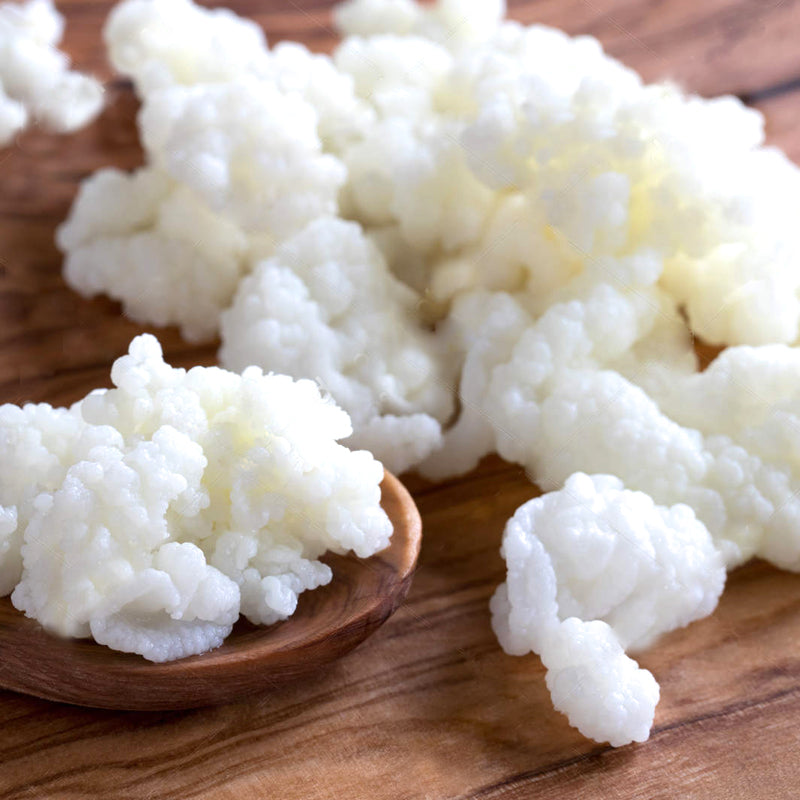
1. Use less grains or use more milk
The ideal ratio of grains to milk is one of the most important ways to get fast healthy grain growth. Fermenting with less grains or using more milk means more nutrients and happier grains. Overcrowded grains is give you a slower rate of growth as they all fight over the same nutrients.
We recommend about 1 teaspoon of grains to 1-2 cups of milk for happy and fast growing grains as well as the most balanced, best tasting kefir.
You can technically get faster growth with more grains, but the overall growth rate is slower and the health of the grains is worse.
2. Make small batches

If you have many grains and you are looking to get more growth out of them, it’s better to do small multiple batches than one giant batch. The reason is that overcrowding of grains and lack of nutrients will almost certainly happen with large batches.
Milk kefir grains generally start the ferment at the bottom of a jar and then rise to the top soon after. So what happens is you have all the grains sitting on the surface pushing upwards and then you big reservoir of milk below them. All the grains are trying to access the nutrients from way above which is not efficient and may be harmful for the grains. It’s a recipe for slower growth.
Smaller batches mean that the grains get better access to nutrients as the grains don’t rise too high during the ferment and there is less competition. And that basically means a better growth rate.
3. Use wider jars or containers
Interestingly enough, many people don’t realize the width of the jar also plays an important role. Tall skinny jars cause the grains to cluster together at the surface in the same way that a big batch does. The nutrients can’t be properly access and the grains suffer for it. Wide jars mean that the grains spread out on the surface and have much better access to nutrients. This in turn will help the grains multiple and grow.
Try fermenting in a shallow bowl (with a cover) instead of a jar.
4. Stir at least once or twice per ferment
Traditionally, milk kefir grains were fermented in a goats skin bags that were constantly agitated. Stirring your milk kefir follows the same idea. The greatest benefit of stirring (at least once or twice per ferment) is to help redistribute the milk so that the grains have greater access to all the nutrients. The result is a more balanced kefir and happier and healthier grains. This will result in faster growth as well.
5. Make sure the temperature is optimal
The optimal temperature for milk kefir grains is in the low 70’s. If its too cold, it can cause imbalance issues or simply slow everything down, including the growth rate. If its warm it may temporarily cause an increase in growth, however, it’s not ideal as it may over-ferment or become yeasty. Over-fermenting may stress the grains and cause slower growth. And if the grains become yeasty, the growth rate naturally slows down.
6. Add whey protein isolate to the ferment
In one study, whey protein isolate actually increased the growth of grains by a whopping 392%. In the same study, modified whey protein also helped, but not nearly as much as whey protein isolate. The study also showed that adding whey protein isolate did not adversely affect the microbial flora of the grains.
With how much the grains easily uptake and utilize whey protein isolate, we recommend using a high quality, non-GMO, grass-fed isolate.
7. Use higher quality milk

Not all milk is created equal. Less processed milk and milk that is grass-fed tends to grow the best. Raw grass-fed milk is the best, but not everyone has that option. Organic pasteurized is a decent choice as well. You can usually taste the difference in milk quality, (especially grass-fed milk) and the grains can as well. They will thrive in higher quality milks and grow at significantly higher rates as well.
8. Try the continuous ferment method
If you have plenty of milk on hand, you can grow grains quite fast. The basic idea is to start with a fairly small amount of milk and continually add milk as it continues to ferment. With milk kefir, the fermented kefir will ferment the fresh milk along with the grains, so it will accelerate fast. In a short amount of time, you will have a very large jar of milk kefir. It is effective in helping grains grow quickly as the process of straining and starting over will slow down the growth. It works best with raw milk as raw milk will naturally ferment slower.
9. Use smaller grains
Smaller grains have more surface area and quicker access to nutrients. This will naturally result in faster grain growth. If you have large grains, you can break them up or cut them up if desired. If you’ve developed a relationship with your grains, it might sound cruel, but it won’t adversely affect them and should end up being happier for it.
What is your favorite method to grow grains fast?


Comments
Clancy
Amazing breakdown
February 08, 2025
Genny
This article was so, very helpful. Thank you so much!
February 08, 2025
Genny
Great info for a beginner Kefir person. Thank you! I look forward to getting your newsletter!
February 08, 2025
Cyrus
Thank you for details 😊
February 08, 2025
Janet
Just want to let you guys know that I appreciate all the great detailed information you guys have on your website. Thanks so much!
May 14, 2023
Leave a comment